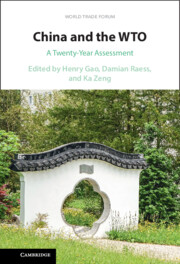Book contents
- China and the WTO
- China and the WTO
- Copyright page
- Contents
- Figures
- Tables
- Contributors
- Preface
- Acknowledgments
- Introduction
- Part I Setting the Stage: Chinese Perspectives on China’s Accession to the WTO
- Part II Political and Economic Implications of China’s WTO Membership
- Part III China and Global Trade Governance
- Part IV Responses of China’s Trading Partners
- Part V China and Investment Governance
- Index
7 - China’s Use of Export Restrictions and WTO Law
Heading toward “Weaponization” of Exports?
from Part II - Political and Economic Implications of China’s WTO Membership
Published online by Cambridge University Press: 14 September 2023
- China and the WTO
- China and the WTO
- Copyright page
- Contents
- Figures
- Tables
- Contributors
- Preface
- Acknowledgments
- Introduction
- Part I Setting the Stage: Chinese Perspectives on China’s Accession to the WTO
- Part II Political and Economic Implications of China’s WTO Membership
- Part III China and Global Trade Governance
- Part IV Responses of China’s Trading Partners
- Part V China and Investment Governance
- Index
Summary
The US-China trade war and looming ‘technological de-coupling’ instigated major revisions of Chinese laws and regulations. These recent amendments represent a major shift in the role assigned to export restrictions. In particular, China is more willing than before to use export restrictions as a geopolitical tool. To test the veracity of this assertion, this chapter analyses China’s use of export restrictions in the period from 2001 to 2021. It suggests that three distinct phases can be discerned: (i) the elimination of export restrictions before and after joining the WTO; (ii) the selective use of export restrictions for domestic policy reasons; and (iii) a shift toward strategic use of export restrictions as an instrument of geopolitical competition. Several implications flow from this new development: it endangers existing supply chains, may bifurcate the global economy by sapping its growth potential and contributes to the erosion of the multilateral trading system.
Keywords
Information
- Type
- Chapter
- Information
- China and the WTOA Twenty-Year Assessment, pp. 160 - 180Publisher: Cambridge University PressPrint publication year: 2023
- Creative Commons
- This content is Open Access and distributed under the terms of the Creative Commons Attribution licence CC-BY-NC 4.0 https://creativecommons.org/cclicenses/
